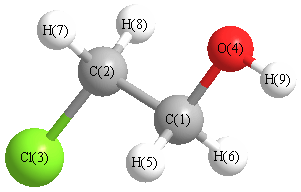Vibrational Frequencies calculated at QCISD(T)/cc-pVDZ
| Mode Number |
Symmetry |
Frequency
(cm-1) |
Scaled Frequency
(cm-1) |
IR Intensities
(km mol-1) |
Raman Act
(Å4/u) |
Dep P |
Dep U |
|---|
| 1 |
A' |
3836 |
3657 |
|
|
|
|
| 2 |
A' |
3104 |
2958 |
|
|
|
|
| 3 |
A' |
3011 |
2870 |
|
|
|
|
| 4 |
A' |
1522 |
1451 |
|
|
|
|
| 5 |
A' |
1490 |
1421 |
|
|
|
|
| 6 |
A' |
1462 |
1394 |
|
|
|
|
| 7 |
A' |
1305 |
1244 |
|
|
|
|
| 8 |
A' |
1238 |
1180 |
|
|
|
|
| 9 |
A' |
1097 |
1045 |
|
|
|
|
| 10 |
A' |
1043 |
994 |
|
|
|
|
| 11 |
A' |
786 |
749 |
|
|
|
|
| 12 |
A' |
390 |
371 |
|
|
|
|
| 13 |
A' |
249 |
237 |
|
|
|
|
| 14 |
A" |
3173 |
3024 |
|
|
|
|
| 15 |
A" |
3056 |
2913 |
|
|
|
|
| 16 |
A" |
1297 |
1236 |
|
|
|
|
| 17 |
A" |
1206 |
1150 |
|
|
|
|
| 18 |
A" |
1058 |
1009 |
|
|
|
|
| 19 |
A" |
800 |
763 |
|
|
|
|
| 20 |
A" |
232 |
221 |
|
|
|
|
| 21 |
A" |
131 |
125 |
|
|
|
|
Unscaled Zero Point Vibrational Energy (zpe) 15742.5 cm
-1
Scaled (by 0.9531) Zero Point Vibrational Energy (zpe) 15004.2 cm
-1
See section
III.C.1 List or set vibrational scaling factors
to change the scale factors used here.
See section
III.C.2
Calculate a vibrational scaling factor for a given set of molecules
to determine the least squares best scaling factor.
